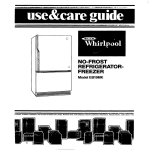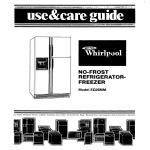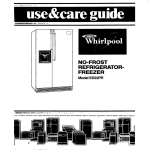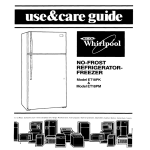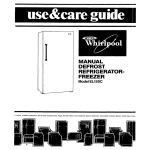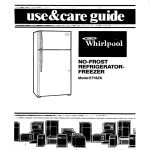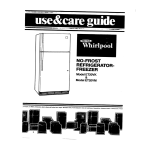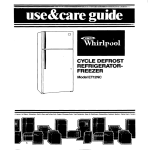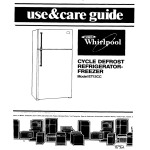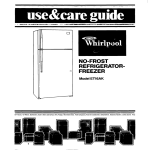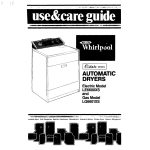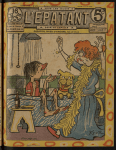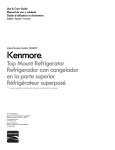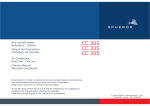Download Whirlpool ET18HM User's Manual
Transcript
0 NO-FROST REFRIGERATORFREEZER Model ET18HM Please read this Use and Care Guide before you do anything else... Thls booklet tells you how to start your refrigerator, clean lt, move shelves and adjust controls. It even tells you what new sounds to expect from your refrigerator. Treat your new refrigerator with care. Use it only to do what home refrigerators are designed to do. Parts and features AUTOMATIC ICE MAKER ADJUSTABLE FREE,ZER SHELF SERIALNUMBER UTILITY COMPARTMENT BUTTER COMPARTMENT POWERSAVING CONTROL MEATDRAWER ADJUSTABLE SHELVES LEVELLING Thank you for buying a Whirlpool appliance. Please complete and mail the Owner Registration Card provided with this product. Then complete the form below. Have this information ready if you need service or call with a question. l l Copy Model and Serial Numbers from label [see diagram above] and purchase date from sales slip. Keep this book and sales slip together in a handy place. Model Number Serial Number Purchase Date Service Company Phone Number 2 Contents i Page 7 Reversing the Door Swing ........... Removing and Adjusting the 7 Freezer Shelf ...................... 7 Automatic Ice Maker ................ 8 Sounds You May Hear ............... 8 Energy Saving Tips .................. 8 CLEANING YOUR REFRIGERATOR....... 9 Cleaning Chart ..................... 10 FOOD STORAGE GUIDE ................ 10 Storing Fresh Food .................. 11 Storing Frozen Food ................. 14 VACATION AND MOVING CARE ........ IF YOU NEED SERVICE OR ASSISTANCE. 15 WHIRLPOOL REFRIGERATOR 16 WARRANTY ............................ Paae SAFElY FIRST .......................... -3 Important Safety Instructions ......... 3 BEFOREUSING YOUR REFRIGERATOR. .. 4 Remove Sales Labels ................ 4 Clean It ............................. 4 Plug Itln ............................ 4 Install Properly ...................... 4 Level Refrigerator-Freezer ........... 4 USING YOUR REFRIGERATOR........... 5 Setting the Controls. ................. 5 Changing the Control Settings ....... 5 Power Saving Control ............... 5 Changing the Light Bulb ............. 6 Moving the Meat Drawer and Cover 6 Adjusting the Refrigerator Shelves ... 6 Removing Crispers and Crisper Cover. ............................ 6 5 i 1 01988 Whirlpool Corporation You are personally responsible for making sure that your refrigerator... l is installed and leveled on a floor that will hold the weight,and in an area suitable for its size and use. l is connected only to the right kind of outlet, with the right electrical supply and grounding. [Refer to your “Electrical Requirements and Grounding Instructions:‘) l is used only to do what home refrigerators are designed to do. l l . . . . is not near an oven, radiator or other heat source. is properly maintained. is out of the weather. is used in an area where the room temperature will not fall below 55°F (13°C). is not used by anyone unable to operate it properly. is not loaded with food before it has time to get properly cold. Before using your refrigerator 4. Install properly... 1. Remove sales labels... Remove the Consumer Buy Guide label, tape and any inside labels before using the refrigerator. To remove any remaining glue: 1. Rub briskly with thumb to make a ball then remove. OR 2. Soak area with liquid hand dishwashing detergent before removing glue as described in step 1. DO NOT USE rubbing alcohol or flammable or toxic solvents, such as acetone, gasoline, carbon tetrachloride, etc. These can damage the material. NOTE: DO NOT REMOVE ANY PERMANENT INSTRUCTION LABELS INSIDE YOUR REFRIGERATOR. Do not remove the Tech sheet fastened under the refrigerator at the front. .:IPlB’~L~F~~~-ea ,~!l~vsu?II.mr* ‘L ,. LII ‘. ZXan Clean cleaning IL,-,.- it... your refrigerator before using it. See instructions on page 8. _: *...1..‘, ilI~aF’,A~~UcpYI~ 3. Plug it in... 3-PRONG OR0 TYPEWALLREC 1. Allow 3 inches (7.5 cm] between overhead cabinets and refrigerator top. 2. Allow at least an inch (2.5 cm) between the refrigerator condenser on the back and the wall. 3. AllowYz inch (1.25 cm) on each side of the refrigerator for ease of installation. 4. If the refrigerator is to be against a wall, you might want to leave extra space on the hinge side so the door can be opened wider. 5. Make sure ice maker water supply has been connected. Refer to Installation Instructions. 5. Level refrigerator-freezer.. . REFRIGERATOR POWERCORD LEVELLINGSCREW . USESCREWDRIVER TO ADJUST RAISE GROUNDING PLUG RECOMMENDED GROUNDING METHOD A 115Volt, 60 Hz., AC only 15 or 20 ampere fused and properly grounded electrical supply is required. It is recommended that a separate circuit serving only this appliance be provided. Do not use an extenslon cord. Use a receptacle which cannot be turned off wlth a switch or pull chain. See individual electrical requirements and grounding instruction sheet in your literature package. 4 HTTO RAISE: LEFTTO LOWEd 1. To raise front, turn each screw to the right. 2. To lower front, turn each screw to the left. 3. Check with level. Using your refrigerator POWERSAVING CONTROL REFRIGER-ATOR CONTROL LlGHi SWITCH FREkZER CONTROI Setting the controls... Controls for the refrigerator and freezer are in the refrigerator. When the refrigerator is plugged in for the first time... 1. Set the REFRIGERA- Give the refrigerator pletely before addlng time to cool down comfood. (This may take sev- is as cold as you like and when ice cream is 2. Set the FREEZER CONTROL to B. Changing the control settings... l If you need to adjust temperatures in refrigerator or freezer, use the settings listed in the chart below. l CONDITION: REASON: If Refrigerator Section is TOO WARM Door opened-often Large amount of food added Room temperature too warm .war.,_” ._, ,,._. Door opened often Large amount of food added Very cold room temperature (can’t cycle often enough) ,I 8.. 1. .?.,., Controls not set correctly for your conditions If Freezer” Section is TOO WARM QUEsTIONS? ...call your COOL-LINE@ service assistance telephone number (page 151. l Adjust the Refrigerator Control first. Wait at least 24 hours between adjustments. Then adjust the Freezer Control if needed. If Refrigerator Section is TOO COLD If BOTH SECTIONS are TOO WARM ’ Door opened often ” Large amount of food added Very warm or very cold room temperatures _. “v+rr: -:Z”.r Refrigerator Freezer @efribGaaT.r - .-. Freezer ,,,“- If ICE isn’t Heavy ice usage MADE FASTENOUGH Very cold room temperature (can’t cycle often enough] -_ RECOMMENDED CONTROL SETTINGS: 1 IIL_.“I)..~I.U.,~II .,,,.,,,w.T.‘a Refrigerator Freezer ,~ <-rU- ,*.s * %&.,r_mll.s Refrigerator Freezer ~.m.FLlr*-cIRefdgerator Freezer .3 A .. 2 B ,, F, 3 A 4 B -.‘___- .:. Power Saving Control... The Power Savlng Control on the Control Console operates electric heaters around the door openings. These heaters help keep moisture from forming on the outside of the refrigerator. Use the “CONSUMES LESSENERGY”setting when humidity is low. 2. Use the “REDUCESEXTERIORMOISTURE” setting if moisture forms on the outside of the refrigerator. 1. 5 Changing the light bulb... 1. Reach behind the control console to find bulb. 2. Remove bulb. 3. Replace with a 40-watt appliance bulb. 8s.”./ ,ts.-, ,. ..r.: ?I/, ,.,,Ilil”H,11.,,6 1 ., ., ,/:.. .,. 1* ., i.FL_r. I . *j -, ., :.*:,. ._._ . ...I- Moving the meat drawer and cover... To remove PULL OUT TO THE STOP. LIFT THE FRONT AND PUL Shelves can be adjusted to match the way you use your refrigerator. the meat drawer: 1. Slide meat drawer out to the stop. 2. Lift the front of meat drawer. 3. Slide drawer the rest of the way out. 4. Replace in reverse order. To remove the cover: 1. Tilt front of cover up, lift at back, and pull straight out. 2. Replace in reverse order. To remove the shelves: 1. Tilt up at front. 2. Lifi up at back. 3. Pull shelf straight out. To replace the shelves: 1. Guide the rear hooks into the slots in the shelf supports. 2. Tilt up front of shelf until hooks drop into slot. Lower front of shelf to level position. PULL OUT TO THE STOP. LlFl THE , ,., FRONT AND PULL AGAIN. To remove the crispers: 1. Slide crisper straight out to the stop, lift front, then slide the rest of the way out. 2. Replace in reverse order. To remove the cover: 1. Push up glass insert from bottom, then slide out with both hands. 2. Lift front of cover frame. 3. Ml out cover frame by pulling up and out. BE CAREFUL. REMOVE THE GLASS INSERT, \ LIFT THE FRAME FRONT, THEN THE BACK. 6 To replace the cover: 1. Fit back of corner into notch supports on walls of refrigerator, then lower into place. 2. Slide back of glass insert into place, then lower front. Reversing the door swing... You can change the hinges on your refrigerator so the doors open the other way. You will need a #20 Torx head screwdriver. Refer to the instruction sheet included with your refrigerator. *” _ Removing and adjusting the freezer shelf...> To remove the shelf: 1. Lift front slightly. 2. Lift back off supports. 3. Replace in reverse order. To adJust the shelf: 1. Remove shelf. 2. Remove supports by sliding upwards. 3. Replace supports on desired level. 4. Replace shelf. ,, j .., b \ SHELF SUPPORT Automatic ice maker... There are a few things you will want to know about your automatic ice maker. l l l l The ON/OFF lever is a wire signal arm. Down...for making ice automatically. Up...to shut off the ice maker. DO NOT TURN ICE MAKER ON UNTIL IT IS CONNECTED TO THE WATER SUPPLY. The dial or lever on the side of the ice maker changes the size of the cubes. Shakethe bin occasionally to keep cubes separated, and to obtain increased storage capacity. It is normal for ice crescents to be attached by a corner. They will break apart easily. You will hear water running when ice maker is working. You’ll hear ice fall into the bin. Don’t let these sounds bother you. The ice maker will not operate until the freezer is cold enough to make ice. This can take overnight. Because of new plumbing connections, the first ice may be discolored or off-flavored. Discard the first few batches of ice. If ice is not being made fast enough and more ice is needed, turn the Refrigerator Control toward a higher number. Wait a day and, if necessary, turn the Freezer Control toward A. If you remove the ice bin, raise the signal arm to shut off the ice maker. When you return the bin, push it all the way in and lower the arm to the ON position. If cubes are stored too long, they may develop an off-flavor...like stale water. Throw them away. They will be replaced. Cubes in the ice bin can also become smaller by evaporation. Good water quality is important for good ice quality. It is not recommended that the ice maker be connected to a softened water supply. Water softener chemicals such as salt from a malfunctioning softener can damage the ice maker mold and lead to poor quality ice. If a softened water supply cannot be avoided,then it is important that the water softener be well maintained and operating properly. Sounds you may hear... YOUr new refrigerator may make sounds that your old one didn’t. Because the sounds are new to you, you might be concerned about them. Don’t be. Most of the new sounds are normal. Hard surfaces like the floor, walls and cabinets can make the sounds seem louder. The following chart describes the kinds of sounds that might be new to you, and what may be making them. _.,9 _ -.a.=. . c ..lil I1cs-.s* .?A--IuI”.- ,...--.,,_1__“_l-,- c__I CI”-lt_C_ - _,_.,- .__,.. -I_ .,u -a.-.. .” Possible Sounds: Probable Causes: .-. ?.__I=-.IP-m..----l Slight Hum, Soft Hiss: You may hear the refrigerator’s fan motor and moving air. -a_,.a Y The thermostat makes a definite click when the refrigerator stops running. * Cllcklng or Snapplng Sounds: It also makes a sound when the refrigerator starts. The defrost timer will click when the defrost cycle starts and stops. .I_--_ l Water Sounds: When the refrigerator stops running, you rnzy hear gurgling in the tubing for a few minutes after it stops. You may also hear defrost water running into the defrost water pan. MIme ,.,_.a.~-m ---xp --.-----a .,m -m-.AI-.-l Ice Maker Sounds: When the ice maker is running you may hear buzzing (from the water - trickling water valve], trickling water and the clatter of ice dumped into the bin. - thud (clatter of ice) .m-.m.wesrLm* -.*-K.e-w- Ill---.-.-w l Runnlng Sounds: Your refrigerator has a high-efficiency compressor and motor. It will run longer than older designs. It may even seem to run most of the time. __-,m--....“W e--e,. _II-l-7Ui-*-.-m 3-1*I**..*-nTM.m* IC’,,C.W Energy saving tips... You can help your refrigerator use less electricity. l Check door gaskets for a tight seal. Level the cabinet to be sure of a good seal. l Clean the condenser coil regularly. l Open the door as few times as possible. Think about what you need before you open the door. Get everything out at one time. Keep foods organized so you won’t have to search for what you want. Close door as soon as food is removed. l Go ahead and fill up the refrigerator, but don’t overcrowd it so air movement is blocked. Cleaning your refrigerator Both the refrigerator and freezer sections defrost automatically. But both should be cleaned about once a month to help prevent odors from building up.Of course, spills should be wiped up right away. To clean your refrigerator turn the Refrigerator Control to OFF, unplug it, take out all removable parts and clean it according to the following directions. 8 It is a waste of electricity to set the refrigerator and freezer to temperatures colder than they need to be. If ice cream is firm in the freezer and drinks are as cold as your family likes them, that’s cold enough. ’ Keep the Power Saving Control on CONSUMES LESSENERGYunless moisture forms on refrigerator exterior. . Make sure your refrigerator is not next to a heat source such as a range, water heater, furnace, radiator or in direct sunlight. l Cleaning chart... . .,^ ,- Part AS, ,.‘ .~ What to use Sponge or cloth; mild detergent and warm water. .. Removable parts ‘(shelves, crisper, meat drawer, etc.) ..w.m, a ,.. “,_ Outside ~~I Sponge, cloth & paper towel;mild detergent; appliance wax [or good auto paste wax). Waxlng palnted metal -*CC-III-aCI s..- - ._ -._,. Sponge, soft cloth or Paper towel, baking soda, warm water, mild detergent. -__I-. Inside walls (Freezer should be allowed to warm up so cloth won’t stick.) ---ZIvm.A. ,. I-= ,-am- Door liners and gaskets ,~/ _--.-_...., -.s -e.-,.-. _ -. jD - Dark plastics (covers and panels) .-.~--.-7- m.,FrI. a”. Defrost pan (behind refrigerator on top of the motor) II,z,I-p-..^ - -ucw_ Floor under refrigerator = II- ylenI . a.. _.“v. .s I. j I ,. .c - ., ,** ,- mm. .*1 =-.“-..-a. How to clean Wash removtjt% paris by hand with” warm water and a mild detergent. l Rinse and dry. . %_-Lr *. - -s...m-“-,” L,- -e.--y..N.; Wash with warm water and a mild detergent. Do not use abmslve or harsh cleansers. l Rinse and dry. l Wax painted metal surfaces at least twice a year with appliance wax or a good auto paste wax. Apply wax with a clean, soft cloth. Do not use wax on plastic parts. surfaces provides rust protection. I and _,...-,., -c a*...I .I . ‘G’gh ,.ih’wa’rm’&&r l -mild detergent or -baking soda (2 tablespoons [26 g] to 1 quart (.95 L.] warm water). l Rinse and dry. .-. -, .;m.Gs ti ,‘~~~““~~~i~-~.~~e~~~~.=~~~arm . ,“_ . *as Sponge, soft ‘clbtti or water. paper towel; mild detergent, warm water. l Rinse and dry. DO NOT USE Cleanlng waxes, concentmted detergents, bleaches or cleansers containing petroleum on plastic parts. 1~-..1-.~-~ ,Y ,,I ,.,,-e ‘. 1^m.*L”I.a/rea.* _,,-*,.“*,,mr _,,,,-ml,,-l.-lsi” ... dI..L-“Z r-,. l Wash with a soft cloth or sponge. Mild detergent and warm water; soft clean l Rinse and dry sponge and soft, clean cloth. DO NOT USE paper towels, window spmys, scouring cleansers, or flammable or toxic solvents llke acetone, gasoline, carbon tetmchlorlde, etc. These can scratch or damage the materlal. ., l,-.iiy. _.,_ s ~,~,,, ,,._“S .” ,.‘,. 3 Ima.L...-LC ~ /~L-..I~mIm-LII.;^Y-C ..--. Sponge or cloth; mild *. l Roll refngerator out away from wall. detergent and warm l Wash defrost pan with warm water water. and mild detergent. Do not remove detrost pan to clean. l Rinse and dry. l Roll refrigerator back into place. ,._^.; clean ,dust:.‘-iid.ii.“f ‘~6K~~~d&‘n”se”r ._;,,l.l Us& Claciium cl6&& coils behind the refrigerator at with brush attachment. least once every other month. l Leave an inch (2.54 cm] between wall and condenser coils on back of the refrigerator. .-_a . -- __ _..” ,,. l Roll refrige&t& &aw76y ~;o&I &%I: -‘. Usual floor cleaners. l Clean the floor. l Roll refrigerator back into place. l Check to see if the refrigerator is level. 5 Food storage guide There is a right way to package and store refrigerated or frozen food. To keep food fresher, longer, take the time to study these recommended steps. STORING FRESH FOOD Cured or Smoked Meat and Cold Cuts. Ham, bacon, sausage, cold cuts, etc., keep best.in original wrappings. Once opened, tightly re-wrap in plastic wrap or aluminum foil. Canned Ham. Store in refrigerator unless the label says it’s okay to store on the shelf. Do not freeze. Fresh Poultry...Wrap in plastic wrap. The plastic on poultry, as purchased, may be used for storage. Leaty Vegetables...Remove store wrapping and trim or tear off bruised and discolored areas. Wash in cold water and drain. Place in plastic bag or plastic containerand store in crisper.Cold, moist air helps keep leafy vegetables fresh and crisp. Vegetables wIthSkins (carrots, peppers)...Store in crisper, plastic bags or plastic container. Frult...Wash, let dry and store in refrigerator in plastic bags ol crisper. Do not wash or hull berries until they are ready to use. Sort and keep berries in their store container in a crisper, or store in a loosely closed paper bag on a refrigerator shelf. STORAGE CHARTFORFRESHAND CUREDMEAT* Approximate lime rVpe Ways) Variety Meats ....................... 1 to 2 1 to 2 Chicken ............................ Ground Beef ........................ 1 to 2 Steaks and Roasts .................. 3 to 5 Cured Meats ........................ 7 to 10 Bacon .............................. 5to7 Cold Cuts ........................... 3 to 5 ‘If meat is to be stored longer than the times given, follow the directions for freezing. NOTE: Fresh fish and shellfish should be used the same day as purchased. MeatYMeat is perishable and expensive...you won’t want to waste an ounce of it through careless handling. The following list and chart give you packaging hints and time limits. Store meat in the meat drawer. Fresh, Prepackaged Meat. Store fresh meat in the store wrapping. Vacuum packaged meat can be frozen for as long as one month if the seal is not broken. If you want to keep it frozen longer, you should wrap it with special freezer wrapping material. Fresh Meat, Not Prepackaged. Remove the marketwrapping paper and re-wrap in aluminum foil for storing it unfrozen. Cooked Meat. Wrap or cover cooked meat with plastic wrap or aluminum foil. Store immediately. 10 Eggs...Store without washing in the original carton on interior shelf. Mllk...Wipe milk cartons. For best storage, place milk on interior shelf. Bevemges...Wipe bottles and cans. Store on a door shelf or inside the refrigerator. Bulter...Keep opened butter in covered dish or in the Butter Compartment. When storing an extra supply, wrap in freezer packaging and freeze. Cheese...Store in the original wrapping until you are ready to use it. Once opened, re-wrap tightly in plastic wrap or aluminum foil. Condiments...Store small jars and bottles (catsup, mustard, jelly, olives) on the door shelves where they are in easy reach. Leftovers...Cover leftovers with plastic wrap or aluminum foil to keep food from drying out and transferring food odors. Plastic containers with tight lids are fine, too. STORING FROZEN FOOD The freezer section is designed for storage of commercially frozen food and for freezing food at home. Packaging-The secret of successful freezing is in the packaging. The wrap you use must be air, moisture and vapor proof. The way you close and seal the package must not allow air, moisture or vapor in or out. Packaging done in any other way could cause food odor and taste transfer throughout the refrigerator and drying of frozen food. Rigid polyethylene (plastic) containers with tight fitting lids, straight-sided canning/freezing jars, heavy-duty aluminum foil, plastic-coated paper and nonpermeable plastic wraps (made from a Saran film) are recommended. NOTE: Heatsealed boiling bags are easy to use and can be used by themselves or as carton liners. Sealing - When sealing food in bags, squeeze out the air [liquids need headspace to allow for expansion). Twist the top and turn it back. Fasten tie securely around the doubled-over tail. Put the label inside transparent bags; use self-adhesive label on outside of opaque ones. DO NOT USE: Bread wrappers l Non-polyethylene plastic containers l Containers without tight lids l Waxed paper l Waxed-coated freezer wrap l Thin, semi-permeable wrap None of these are totally moisture, air or vapor proof. The use of these wrappings could cause food odor and taste transfer and drying of frozen food. l Freezing Fruits - Select ripe, blemish-free fruits. Be sure they taste as good as they look. Wash 2 to 3 Air-tight wrapping calls for “drugstore” wrap. Cut quarts [liters] at a time and drain. Fruit that stands in the sheet about one-third longerthan the distance water may lose food value and become soggy. around the food. Bring the ends together and fold Sort, peel, trim, pit and slice as needed. Pack in rigid wide-mouthed containers or other in (toward the food) at least twice to seal out air. recommended material. Leave head space to Crease ends close to food, press air from package. Fold tips over twice. Finish package and tape allow liquids to expand during freezing. closed. NOTE: With unboned meats, pad sharp edges wlth extra wrap or use stockinette to protect the wrap from punctures. Freezing Vegetables - Freeze only fresh highquality vegetables picked when barely mature. For best results, freeze no more than 2 to 3 hours after picking. Wash in cold water, sort and cut into appropriate sizes. Blanch or scald. Pack in recommended container and freeze. Do not freeze lettuce, celery, carrot sticks, potatoes or fresh tomatoes. All will become limp or mushy. Tomatoes will collapse when thawed. Freezing Cooked Food -Prepare cooked foods as you would for the table; shorten cooking time 10 to 15 minutes to allow for additional cooking during reheating. Omit seasonings and part of the liquid. Plan to add them at reheating time. Potatoes should also be added to soup and stew at heating time. Add crumb and cheese toppings at heating time. Cool as rapidly as possible and freeze at once. Liquid or semi-liquid dishes may be frozen in recommended containers with head-space. Casseroles and other more solid foods may be frozen in the baking container. If you don’t want to leave your casserole dish in the freezer, line it with foil. Bake, cool, freeze, lift out the foil package, bag it and return to freezer. Freezlng Meats - The meat you thaw can only be as good as the meat you freeze. “Drugstore” wrap in meal-size packages. Flat cuts or patties should be wrapped individually or in layers separated by a double thickness of freezer wrap. Make sure store wrappings are moisture and vapor proof. If not, re-wrap meats with one of the wraps recommended under “Packaging:’ Freezing Baked Goods- Wrap baked breads in recommended material. Thaw in wrapping. Unbaked yeast breads can be frozen after the first rising. Punch down, wrap and freeze. Bake cookies as usual. Cool and freeze on trays, then pack in recommended freezer bags or cartons. Unbaked cookies may be dropped, molded or rolled and frozen on cookie trays. Store in bag or carton; bake without thawing. Refrigerator-type cookies can be wrapped and frozen in roll form. Thaw only enough to slice when ready to bake. Fruit pies are best frozen unbaked. Bake without thawing. Bake pecan and similar pies before freezing...rich fillings do not freeze solid. Cut steam vents in top crusts when ready to bake. 12 IMPORTANT: Do not expect your freezer to quickfreeze any large quantity of food. Put no more unfrozen food into the freezer than will freeze within 24 hours. (No more than 2 to 3 pounds of food per cubic foot of freezer space.) leave enough space for air to circulate around packages. Be careful to leave enough room at the front so the door can close tightly. FOODSTORAGECHART Storage times’ will vary according to the quality of the food, the type of packaging or wrap used (moisture and vapor-proof), and the storage temperature which should be 0°F ( -17.WC). Storage Tlme Food FRUITS ........ 12 months Frult Juice concentrate Commercially frozen fruit ..... 12 months 4 to 6 months CltNS fNlt and JUlCeS ...... 8 to 12 months Others .................... VEGETABLES 8 months Commercially frozen .......... 8 to 12 months Home frozen .............. MEAT 4 weeks or less Bacon .................... 4 weeks or less Corned beef ............. (Salting meat shortens freezer life) 1 month Frankfurters ..................... Ground beef, iamb, veal ... 2 to 3 months Roasts: 6tol2months Beef .................... 6 to 9 months lamb and veal .......... 4to8months Pork ..................... 1 to 2 months Sausage, fresh ............. Steaks and chops: 8tol2months Beef .................... 3 to 4 months lamb, veal, pork ......... FfSH Cod, flounder, haddock 6months sole ......................... 2 to 3 months Blue flsh, salmon ........... 2 to 3 months Mackerel, perch ........... ...... 3 months Breaded fish (purchased) Clams, oysters, cooked 3 to 4 months fish, crab, scallops ....... IO months Alaskan king crab ............ Shrimp, uncooked ............ 12 months POULTRY Chicken or turkey, whole or parts .............. 12 months Duck .......................... 6 months 2to3months Giblets .................... 6 months Cooked poultry w/gravy ....... 1 month SllCeS (no gravy) ................ MAIN DISHES Stews; meat, poultry 2 to 3 months and fish casserole ....... 3 to 6 months TV dlnners ................. Storage time Food DAIRY PRODUCTS 6toOmonffw Bufter ...................... 12 months Margarfne ..................... Cheese: Camembert, Yonarelia, 3monfhs fanner% .................... DO NOT FREE2E Creamed cottage ...... Cheddar, Edam, Gouda, ........ 6to8weeks SwNs,briok,etc. keeting can change texture of ChOOSO. ice cream, Ice mifk, sherbet ..... 2 months EGGS 12 mOfIlhS Whole (mfxed) ................. 12months Whites ......................... I2 months Yolks ........................... (Add sugar or salt to yolks or-whole mixed eggs] BAKED GCODS ........ 3montfts Yeastbrwadsandroiis.. .... 3montfts BakedBrown WServeroiis.. 1 month Unbaked breads ................ .............. 2to3months Qufckbreads ........... 2to4months Cakequnfrosted ............ 8to12monffts Cake&frosted 12 monfhs hit cakes .................... 3 monfhs Cookie dough .................. .......... 8tol2monfhs Bakedcookies.. ............... 1 to2monfhs Bakedpfes.. ............. 4to6monfhs Piedoughoniy *Based on U.S.D.A. and Mlchlgan Cooperatlve Ex-tenslon Service suggested storage times. If electricity goes off Call the power company. Ask how long power will be off. 1. If service is to be interrupted 24 hours or less, keep both doors closed. This will help frozen foods to stay frozen. 2. If service is to be interrupted longer than 24 hours: (a] Remove all frozen food and store in a frozen food locker. Or... (b) Place 2 Ibs (0.9 kg] of dry ice in freezer for every cu. ft. of freezer space. This will keep frozen foods for 2 to 4 days. Wear gloves to protect your hands from dry ice burns. (c) If neither food locker storage nor dry ice is available, use or can perishable food at once. 3. A full freezer will stay cold longer than a partly filled one. A freezer full of meat will stay cold longer than a freezer full of baked goods. If food contains ice crystals, it may be Safely refrozen, although the quality and flavor may be affected. Use refrozen foods quickly. If the condition of the food is poor or if you feel it is unsafe, dispose of it. Vacation and Moving Care Short vacations... Moving... No need to shut off the refrigerator if you will be away for less than four weeks. Use up perishables; freeze other items. 1. Turn off your ice maker. 2. Shut off the water supply to the ice maker. 3. Empty the ice bin. Shut off the ice maker water supply a day ahead of time. Disconnect the water line. After the last sup ply of ice drops, lift the signal arm to turn off the ice maker. Remove all food. Pack frozen foods in dry ice. Unplug the refrigerator and clean it thoroughly. Remove everything that comes out. Wrap all parts well and tape them together so they don’t shift and rattle. Screw in the levelling rollers; tape the doors shut; tape the electric cord to the cabinet. When you get to your new home, put everything back, level the refrigerator, reconnect the water supply and refer to page 4. Long vacations... Remove all the food if you are going for a month or more. At least a day ahead, turn off the water supply to the ice maker. When the last load of ice drops, turn off the ice maker. Unplug the refrigerator and clean it...rinse well and dry. Tape rubber or wood blocks to the tops of both doors...keeping them open far enough for air to get in. This will keep odor and mold from building up. To restart refrigerator, erator:’ 14 see “Using Your Refrig- Bueslions? ...call your COOL-LINES service assistance telephone number (page 15). If you need service or assistance, we suggest you follow these five steps: 2. If you need assistance?.. 1. Before calling for assistance... Performance problems often result from little things you can find and fix yourself without tools of any kind. Call Whlrlpool phone number. H your rdrtgemtor will not operate: Is the electric cord plugged into a live circuit with proper voltage? (See page 4.) l Have you checked your home’s main fuses or circuit breaker box? l Is the Refrigerator Control ON? l It there Is a mttllng or Jlngllng nolre or untamlllar sounds: l Is something on top or behind the refrigerator making noise when the refrigerator is running? l New features on your new refrigerator make new sounds. You may be hearing air flowing from the fans, timer clicks for the defrosting cycle, or defrost water draining in the defrost pan. If your Ice maker will not operate: Has the freezer had enough time to get cold? With a new refrigerator, this might take overnight. l Is the signal arm ON...in the down position? l Is the water valve turned on? Is water getting to the ice ma ket? l COOL-LINE~n servlce a&stance teleDlal free from anywhere In the U.S.: I-800-253-1301 and talk with one of our trained Consultants. The Consultants can instruct you in how to obtain satisfactory operation from your appliance or, if service is necessary, recommend a qualified service company in your area. 3. Whirlpool has a nationwide network of franchised TECH-CARE’” service companies. TECH-CARE service technicians are trained to fulfill the product warranty and provide afterwarranty service, anywhere in the United States. To locate TECH-CARE service in your area, call our COOLLINE service assistance telephone number (see Step 2) or look in your telephone directory Yellow Pages under: WHIRLPOOL APPLIANCES FRANCHISED TECH-CARE SEAVICE SERVICE XYZ SERWICECO 123 MAPLE Ii there Is water In the detrost pan: This is normal in hot, muggy weather. The pan can even be half full. Make sure the refrigerator is level so the pan does not overflow. If the motor seems on page WHIRLPOOL APPLIANCES FRANCHISED TECH-CARE SERVICE SERVICE XYZ SERVICECO 123 MAPLE COMPANIES 999.9999 COMPANIES 9999999 WASHING MACHINES, DRYERS A IRONERS-SERVICING WHIRLPOOL APPLIANCES FRANCHISED TECH-CARE SERVICE If the light does not work: Have you checked your home’s main fuses or circuit breaker box? l Is the power supply cord plugged into a live circuit with the proper voltage? (See page 4.) light bulbs OR OR l It a bulb Is burned out: See instructions for changing Use appliance bulbs only. ELECTRICAL APPLIANCESMAJOR - REPAIRING A PARTS APPLIANCES-HOUSEHOLDMAJOR - SERVlCE 6 REPAIR l l If you need service?.. ( SERVICE XYZ SERVICECO 123 MAPLE COMPANIES 999.9999 4. If you have a problem?.. 6. to run too much: . Is the condenser free of dust and lint? l On hot days, or if the room is warm, the motor naturally runs longer. l If the door has been opened a lot, or if a large amount of food has been put in, the motor will run longer to cool down the interior. Remember: Motor running time depends on different things; number of door openings, amount of food stored, temperature of the room, setting of the controls. And, your new refrigerator may be larger than your old one so it has more space to be cooled. It also has a regular freezer instead of a frozen food compartment. All this means better refrigeration and may require more running time than your old one. Call our COOL-LINE service assistance telephone number (see Step 2) and talk with one of our Consultants, or if you prefer, write to: Mr. Donald Skinner Director of Customer Relations Whirlpool Corporation 2000 M-63 Benton Harbor, Ml 49022 5. If you need FSP” replacement parts%.. FSP” is a registered trademark of Whirlpool Corporation for quality parts. Look for this symbol of quality whenever you need a replacement part for your Whirlpool appliance. FSP replacement parts will fit right and work right, because they are made to the same exacting specifications used to build every new Whirlpool appliance. To locate FSP replacement parts in your area, refer to Step j-above or call the Whirlpool COOL-LINE service assistance number in Step2 *If you must call or write, please provide: model number, serial number, date of purchase, and a complete description of the problem. This information iS needed in order to better respond to your request for assistance. WH1RLPOOI.F REFRIGERATOR WARRANTY LEHMH OF WARRANYY WHIRLPOOL RF00 --- -- WILL PAY FOR From Date of Purchase FSP replacement park and repalr labor to correct defects in materials or workmanshlp. Servlce must be provlded by a franchised TECH-CARE@service company. UMITED PM-YEAR WARRANlV From Date of Purchase FSPreplacement parts for electronic control system If defective in materlals or workmanshla fElectronlc models 0nlv.l M.l FSPreplacement parts and repalr labor to correct defects in materlals or workmanshlp In the sealed refrigeration system. These parts are: 1. Compressor 2. Evaporator 3. Condenser 4. Drier 5. Connecting tubing Service must be provlded by a franchised TECH-CARE@service company. WLL ONWEAR WARRANTY FIVE-YEAR WARRANTY From Date of Purchase WHIRLPOOL WILL NOT PAY FOR A. Servlce calls to: 1. Correct the Lnstallatlon of the refrlgerator. 2. Instruct you how to use the refrigerator. 3. Replace house fuses or correct house wlrlng or plumbing. 4. Replace light bulbs. 1. Repalrs when refrlgerator is used In other than normal, slngle-family household use. C. Pick up and dellvery. This product Is deslgned to be repaired In the home. D. Damage to refrlgemtor caused by accident. misuse, fire, flood, acts of God or use of products not approved by Whlrlpool. E. Any labor costs durlng Ilmlted warranty. F. Any food loss due to Droduct failure. WHIRLPOOLCORPORATION SHALL NOT BELIABLEFOR INCIDENTAL OR CONSEQUENTIAL DAMAGES. Some states do not allow the exclusion or Ilmltatlon of lncldental or consequentlal damages so thls llmltation or exclusion may not apply to you. Thls warranty gives you specific legal rights, and you may also have other rlghts which vary from state to state. Outslde the United States, a different warranty may apply. For details. please contact your franchised Whlrlpool distrlbutor or mllltary exchange. Part No. 1120606 01988 Whirlpool Corporation Printed in U.S.A. is’.>,.*‘ Ice Makers Dishwashers Built-In Ovens and Suriace Umls Ranges Microwave Ovens. Trash Compaclon. 1, I’.a:.LI;IFtll*~q:*.~gm Room Air Condilioners. Oehumidiliers -Aulomalic Washers. Clothes Dryers, Freezers Relrigeti


















